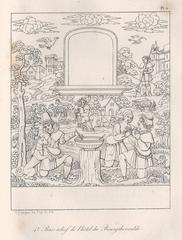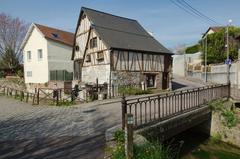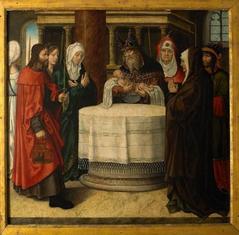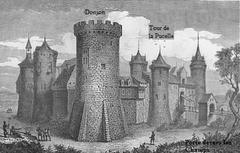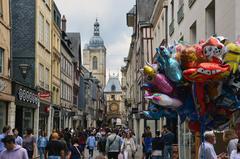
Abbaye de Saint-Amand: Visiting Hours, Tickets, and Historical Significance in Rouen
Date: 04/07/2025
Introduction
The Abbaye de Saint-Amand in Rouen, Normandy, is a remarkable monument that encapsulates centuries of France’s monastic, architectural, and cultural history. Founded in the 7th century, possibly atop a Roman temple and connected to the missionary Saint Amand, the abbey has survived Viking invasions, medieval refoundations, and the upheavals of the French Revolution. Today, it stands as an emblem of Rouen’s spiritual and artistic heritage, renowned for its rare timber-framed medieval architecture and its exceptional painted oak woodwork—now preserved in the Musée de la Céramique de Rouen (academia.edu; parisladouce.com). This guide details the abbey’s origins, architectural evolution, religious and cultural significance, and provides practical information for visitors.
Historical Overview
Early Foundations and Legendary Origins
Legend holds that the abbey was established on the site of a Roman temple to Venus during the reign of Clovis II in the 7th century (Wikipedia). Saint Amand himself, a key figure in Merovingian religious life, is credited with its consecration (Rouen Histoire). Archaeological evidence points to Roman foundations beneath the abbey, reinforcing its longstanding sacred status (France-Voyage).
Monastic Community and Development
By the 9th century, the site was recognized as a female Benedictine monastery, serving as a center for religious women and spiritual scholarship. The original buildings were destroyed during Viking raids in the 9th century, but the abbey was refounded in 1030 by Gosselin d’Arques and Emmeline with support from Duke Robert the Magnificent (Wikipedia). This period marked an era of monastic renewal in Normandy, with influential patrons like William the Conqueror contributing to the abbey’s growth (France-Voyage).
Medieval Prominence
The abbey church, dedicated to Notre-Dame and Saint Amand, was consecrated in 1068 (Rouen Histoire). In 1100, it became the parish church of Saint-Amand, with the choir reserved for the monastic community and the nave open to parishioners (Wikipedia). Over the medieval and early modern eras, the abbey thrived as a spiritual, educational, and artistic hub, governed by a succession of abbesses closely tied to the Norman aristocracy (Numilog).
Decline and Revolution
The abbey’s fortunes declined in the early modern period, with the French Revolution marking a decisive end to its religious role. After 1789, the abbey was nationalized and most of its buildings were demolished between 1797 and 1820. Only fragments, such as a wooden façade and a turret from the abbess’s residence, survived and are now preserved as historical monuments (Monumentum).
Architectural and Artistic Heritage
Timber-Framed Construction: Medieval Innovation
The surviving 13th-century timber-framed building at 6 rue Saint-Amand exemplifies medieval Norman craftsmanship. Restoration and studies revealed a grand hall over 36 meters long, with original roof trusses—one of Normandy’s rare timber-framed monastic structures (academia.edu). The structure features a central hall, porches, and residential spaces, demonstrating the spatial logic and communal functions of Benedictine monastic life.
Decorative Woodwork and Painted Panels
A highlight of the abbey’s artistic legacy is the 193 oak wood panels (boiseries) now at the Musée de la Céramique de Rouen (parisladouce.com). These panels are adorned with oil-painted garlands, botanical motifs, and religious figures—including the Virgin Mary, the Archangel Gabriel, Saint Margaret, and Saint Mary Magdalene—reflecting both spiritual symbolism and refined artistic taste. The woodwork, likely created in the early 17th century, is a testament to the abbey’s patronage of the arts and the transition from Renaissance to Baroque aesthetics.
Restoration and Preservation
Restoration efforts in the 1980s, led by Michel Ratier and the Atelier d’urbanisme de Rouen, ensured the survival of the timber structure and its artistic details (academia.edu). Today, guided tours and museum displays allow visitors to appreciate these rare examples of medieval and early modern ecclesiastical art.
Religious and Cultural Significance
Monastic Life and Spiritual Influence
As a Benedictine institution, the abbey emphasized prayer, work, and study, serving as a center for manuscript production and theological learning. It played a central role in Rouen’s religious landscape, participating in liturgical celebrations and local festivals. The cult of Saint Amand, celebrated on February 6, drew pilgrims and reinforced the abbey’s spiritual importance (PlanetWare).
Community and Educational Role
The abbey was also a center of charity, education, and social welfare, providing for the poor, the sick, and travelers. Its library and scriptorium contributed to the preservation and dissemination of classical and Christian texts, while its influence extended into local customs and civic celebrations (French Moments; Vitrines Rouen).
Artistic and Musical Legacy
The abbey’s liturgical life fostered the development of sacred music and visual arts in Rouen. Gregorian chant and polyphony flourished, and the city’s reputation for organ and choral music can be traced, in part, to the traditions established by its monastic communities (Visite Rouen).
Visiting the Abbaye de Saint-Amand: Practical Information
Opening Hours
- Abbey Remnants and Cathedral: Accessible year-round, typically from 9:00 AM to 6:00 PM (hours may vary; verify with local tourism sources).
- Musée de la Céramique: Tuesday to Sunday, 10:00 AM to 6:00 PM; closed Mondays and public holidays.
Tickets and Admission
- Entry: Free access to the abbey remnants and the Rouen Cathedral. Museum entry is approximately €7 (discounts for students/seniors; children under 12 free). Special exhibitions or guided tours may have fees.
- Purchase: Tickets available on-site or via Rouen’s official tourism portal.
Accessibility
- Most sites are accessible to visitors with limited mobility; some historic buildings may have uneven terrain. Contact the tourist office for details.
Guided Tours and Events
- Guided tours can be booked through the Rouen Tourist Office, offering in-depth insights into the abbey’s history and art.
- Special events, including festivals and exhibitions, are periodically held; check local listings and the official website.
Nearby Attractions
- Combine your visit with Rouen Cathedral, Gros Horloge, Musée des Beaux-Arts, and the medieval old town for a comprehensive experience (thecrazytourist.com).
Photography
- Photography is permitted; please avoid flash in museum areas.
Exploring Abbaye de Saint-Amand in Saint-Junien (Nouvelle-Aquitaine)
Location and Access
Distinct from the Rouen abbey, the Abbaye de Saint-Amand in Saint-Junien (Limousin) is a designated Monument Historique (BaladoDécouverte). Easily accessed by car or regional train, the site features open-air terraces with panoramic views and is integrated into local walking and cycling routes.
Visiting Hours and Tickets
- Terraces: Open daily from dawn to dusk, year-round; free access.
- Events: Guided tours, reenactments, and concerts offered seasonally, often free or at a nominal fee (BaladoDécouverte).
Visitor Experience
- Terraces and Ruins: Informational panels and QR codes provide historical context; panoramic vistas over the Vienne valley.
- Digital Resources: The BaladoDécouverte app offers audio guides and GPS navigation.
- Community Engagement: Events and educational initiatives connect the site with local schools and residents.
Summary: Why Visit the Abbaye de Saint-Amand?
The Abbaye de Saint-Amand is a vital part of Normandy’s monastic heritage, offering a rare glimpse into medieval craftsmanship, religious art, and the evolution of monastic life. Its preserved timber-framed architecture and painted boiseries are unique in France, and its spiritual, educational, and charitable legacy continues to resonate in modern Rouen. For a deeper experience, take advantage of guided tours, digital resources, and cultural events, and explore related sites in both Rouen and Saint-Junien to appreciate the diversity of France’s monastic traditions (academia.edu; parisladouce.com; Rouen Histoire).
Frequently Asked Questions (FAQ)
Q: What are the visiting hours of the Abbaye de Saint-Amand?
A: The Rouen site is usually accessible during Rouen Cathedral hours (9:00 AM–6:00 PM). The Musée de la Céramique is open Tuesday to Sunday, 10:00 AM–6:00 PM.
Q: Is there an entrance fee?
A: Entry to the abbey remnants and cathedral is free. Museum entrance is about €7; guided tours may require additional fees.
Q: Are guided tours available?
A: Yes, through the Rouen Tourist Office and local operators.
Q: Is the site accessible for visitors with disabilities?
A: Most areas are accessible, but some historic sections may have limitations.
Q: Can I take photographs?
A: Photography is allowed, but flash and tripods may be restricted in museum spaces.
Sources and Further Reading
- France-Voyage
- academia.edu
- French Moments
- BaladoDécouverte
- Wikipedia
- Monumentum
- parisladouce.com
- PlanetWare
- Vitrines Rouen
- Visite Rouen









